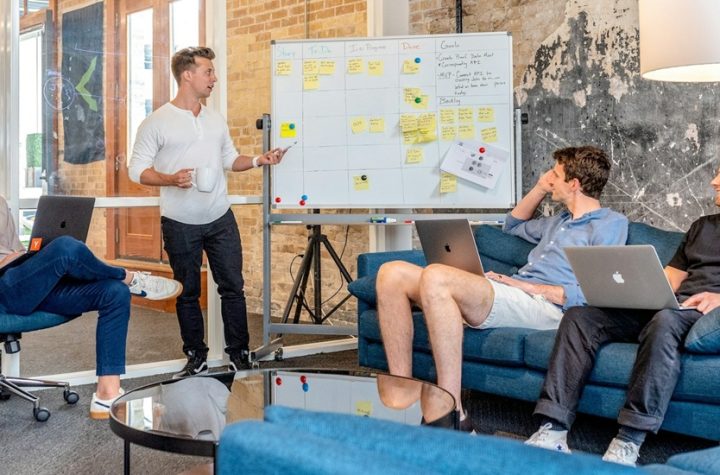
Pic Courtesy - Unsplash
Innovation. It’s the lifeblood of any successful business, the engine that drives growth, and the key to staying ahead in an ever-evolving marketplace. Yet, maintaining a consistent stream of fresh ideas and turning them into tangible realities is a perpetual challenge. The business landscape is littered with the remnants of companies that once shone brightly, only to fade into obscurity because they failed to innovate. They became complacent, clinging to outdated models while their competitors, driven by innovation, surged ahead.
This blog post will delve into the critical importance of continuous innovation and provide a practical, three-step framework to help your business not only survive but thrive in the face of constant change. We’ll also explore a real-world case study to illustrate these principles in action.
1. The Relentless Pace of Change:
The world is changing faster than ever before. Technological advancements, shifting consumer preferences, and global economic forces are constantly reshaping the playing field. What was cutting-edge yesterday can be obsolete tomorrow. In this dynamic environment, standing still is akin to falling behind. Businesses must be agile, adaptable, and, above all, innovative to remain competitive.
Innovation isn’t just about inventing the next groundbreaking product. It encompasses a wide range of activities, from improving existing processes and services to developing entirely new business models. It’s about finding creative solutions to problems, anticipating future needs, and constantly seeking ways to add value for customers.
Real-World Case Study: Nokia
No discussion about the pace of change is complete without examining Nokia. Once the undisputed leader of mobile phones, Nokia dominated the global market in the early 2000s. Its devices were iconic — durable, beloved, and everywhere.
Yet Nokia failed to see the smartphone wave coming. While the iPhone and Android redefined consumer expectations, Nokia clung to its Symbian operating system and traditional hardware design. Internal culture was risk-averse, with leadership reluctant to disrupt their existing cash cows.
The result? Nokia lost relevance almost overnight, going from market leader to near total collapse in less than five years. The lesson: even market giants can fall if they fail to match the relentless pace of change.
2. The Cost of Complacency:
The consequences of failing to innovate can be severe. Companies that cling to the status quo risk losing market share, becoming irrelevant, and ultimately, failing altogether. History is replete with examples of once-dominant companies that fell victim to their own complacency. Think of Blockbuster, which failed to recognize the rise of online streaming, or Kodak, which clung to film photography even as digital cameras revolutionized the industry. These companies failed to adapt and innovate, and they paid the ultimate price.
Real-World Case Study: Blockbuster
Let’s revisit Blockbuster. In 2000, Reed Hastings offered Blockbuster the chance to buy Netflix for $50 million. Blockbuster declined. Their leaders felt their brick-and-mortar model was too strong to be disrupted.
Fast forward to 2010: Blockbuster filed for bankruptcy. Meanwhile, Netflix reinvented itself multiple times — from DVD rentals to streaming to original content production — constantly innovating in both technology and business model.
Blockbuster’s complacency and lack of imagination became its death sentence, showing us how innovation is not optional; it is existential.
3. The Three Pillars of Continuous Innovation:
So, how can businesses cultivate a culture of innovation and ensure a steady flow of fresh ideas? While there’s no magic formula, a structured approach can significantly increase your chances of success. We propose a three-step framework:
1. Foster a Culture of Creativity:
Innovation doesn’t happen in a vacuum. It requires a fertile ground where creativity can flourish. This starts with creating a company culture that values and encourages new ideas.
- Embrace Open Communication: Break down silos and encourage open communication between departments and teams. Create platforms for employees to share their ideas, feedback, and suggestions. This could be through regular brainstorming sessions, suggestion boxes (physical or digital), or dedicated innovation platforms.
Case Study: Pixar
Pixar is legendary for its open communication. Its “Braintrust” meetings bring together directors, producers, writers, and artists to candidly review projects at every stage. Everyone’s ideas matter, and even the harshest critiques are seen as opportunities to make the story stronger. Pixar’s collaborative, cross-disciplinary culture has produced blockbuster after blockbuster, from Toy Story to Inside Out. They have shown that open communication can turn creative visions into commercially successful art, repeatedly.
- Promote Psychological Safety: Employees need to feel safe to express their ideas without fear of ridicule or reprisal. Create an environment where experimentation and even failure are seen as learning opportunities. A culture of fear will stifle creativity and prevent employees from taking risks.
Case Study: Google
Google’s landmark “Project Aristotle” studied hundreds of its own teams to understand why some were more successful than others. The single biggest predictor of high performance? Psychological safety. Teams that felt safe to speak up, make mistakes, and challenge each other without retaliation were far more innovative. That lesson inspired Google to design management training and team norms specifically to cultivate this safety net — leading to even greater innovation, from Gmail to TensorFlow to Google Brain.
- Reward and Recognize Innovation: Recognize and reward employees who contribute innovative ideas, regardless of whether those ideas ultimately lead to successful products or services. This reinforces the importance of innovation and motivates employees to think creatively.
Case Study: 3M
3M is famous for rewarding employee initiative through its “15% rule,” letting employees dedicate 15% of their time to passion projects. Post-it Notes — one of 3M’s most profitable innovations — emerged directly from this program. By encouraging and rewarding creative exploration, 3M institutionalized innovation into its DNA, inspiring employees to think big.
- Lead by Example: Leaders must champion innovation and demonstrate their own commitment to creativity. Show that you are willing to take risks and experiment with new approaches. Your enthusiasm will inspire others to do the same.
Case Study: Amazon
Jeff Bezos, for instance, famously described Amazon as “the best place to fail.” From launching the Fire Phone (which bombed) to acquiring Zappos to developing Alexa, Bezos showed an unrelenting willingness to experiment and pivot.That attitude created a culture where risk-taking was not just tolerated but celebrated, leading to breakthroughs like Amazon Web Services (AWS), now a cornerstone of global cloud infrastructure.
- Embrace Diversity: A diverse workforce brings a wider range of perspectives and experiences, which can fuel creativity and lead to more innovative solutions. Encourage diversity in terms of gender, race, ethnicity, background, and thought.
Case Study: Johnson & Johnson
Johnson & Johnson consistently ranks among the world’s most innovative healthcare firms. They credit their diverse, global workforce as a key advantage. By drawing on perspectives from across cultures, genders, and educational backgrounds, J&J develops products that resonate globally — from advanced surgical robotics to consumer health.
Takeaway:
Fostering a culture of creativity is the foundation of sustainable innovation. Ideas flourish where communication is open, safety is assured, diverse perspectives are welcomed, and leaders actively champion bold thinking.
2. Invest in Research and Development (R&D):
R&D is the engine that drives innovation. It involves investing resources in exploring new ideas, developing prototypes, and testing new technologies.
- Allocate Dedicated Resources: Set aside a specific budget for R&D activities. The amount you invest will depend on your industry and business goals, but it’s crucial to demonstrate a commitment to innovation through tangible investment.
Case Study: Apple
Apple’s annual R&D budget is now over $30 billion. Even during economic slowdowns, Apple prioritizes investment in R&D. This commitment fuels breakthroughs in hardware, chips, health features, and AR/VR technologies — giving Apple consistent product superiority and strong pricing power.
- Focus on Strategic Areas: Don’t spread your R&D resources too thin. Identify key areas that are aligned with your business strategy and focus your efforts on those areas.
Case Study: Tesla
Tesla focuses R&D resources specifically on batteries, autonomous driving, and sustainable energy. These areas directly support its mission to accelerate the world’s transition to sustainable energy. That focused R&D strategy allowed Tesla to build an ecosystem few rivals can match — from the Gigafactory to Full Self-Driving algorithms — cementing its first-mover advantage.
- Collaborate with External Partners: Consider partnering with universities, research institutions, or other companies to leverage their expertise and resources. Collaboration can accelerate the innovation process and bring fresh perspectives.
Case Study: IBM
IBM’s “Watson” project was not developed solely in-house. IBM collaborated with universities and medical centers to train Watson on complex data sets for healthcare and finance. This partnership-based R&D approach created solutions far beyond what IBM could have achieved alone — giving Watson global relevance.
- Stay Ahead of the Curve: Keep abreast of the latest trends and technologies in your industry. Attend conferences, read industry publications, and network with other professionals. Staying informed is crucial for identifying new opportunities and staying ahead of the competition.
Case Study: Nike
Nike invests deeply in trend scouting and innovation labs. It continually experiments with smart materials, 3D printing, and even NFTs. By reading cultural signals early, Nike repeatedly redefines what performance gear looks like — as with Flyknit shoes and self-lacing sneakers.
Takeaway:
Treat R&D as your innovation engine. Resource it properly, focus it strategically, and partner externally to stay on the cutting edge.
3. Encourage Experimentation within Your Team:
Innovation is not a linear process. It often involves trial and error, setbacks, and unexpected discoveries. Encourage your team to experiment, take risks, and learn from their mistakes.
- Create a Culture of Experimentation: Foster a culture where experimentation is seen as a valuable part of the innovation process. Encourage employees to try new things, even if there’s a chance of failure.
Case Study: Netflix
Netflix constantly runs A/B tests — on pricing, user interfaces, even thumbnails. Employees are encouraged to design experiments, measure results, and learn from them. This experimentation-first culture helped Netflix transform from DVD rentals to streaming, and then to content production. They tested, pivoted, and iterated their way to a $200+ billion enterprise.
- Embrace Agile Methodologies: Agile methodologies, such as Scrum or Kanban, are designed to promote iterative development and experimentation. These approaches allow teams to quickly test new ideas and make adjustments based on feedback.
Case Study: Spotify
Spotify uses a highly Agile “squad” model, where small, cross-functional teams own specific product areas and iterate quickly. Each squad acts like a mini-startup inside the bigger company, promoting rapid experimentation and avoiding bureaucratic roadblocks. That’s how Spotify constantly refines its recommendation engine and adds features — like collaborative playlists and lyrics — faster than competitors.
- Provide Resources for Experimentation: Give your team the resources they need to experiment, including time, budget, and equipment. Show them that you are willing to invest in their ideas.
Case Study: Microsoft
Under Satya Nadella, Microsoft invested resources specifically for experimentation. Its Garage program lets employees hack on projects outside their day jobs, with budget, mentors, and lab equipment. Ideas born in the Garage — like Seeing AI for visually impaired users — turned into real products.
- Learn from Failures: Not every experiment will be successful. When things don’t go as planned, don’t assign blame. Instead, analyze what went wrong and use the experience as a learning opportunity. Fail fast, learn faster.
Case Study: SpaceX
SpaceX embodies “fail fast, learn faster.” Early rocket tests spectacularly exploded, but every failure was meticulously analyzed. Instead of retreating, SpaceX iterated quickly. Today, they lead the commercial space race, demonstrating how even catastrophic failures can be stepping stones toward enormous success.
Case Study: Netflix – From DVD Delivery to Streaming Giant:
Netflix is a prime example of a company that has consistently embraced innovation to stay ahead of the curve. Founded in 1997 as a DVD rental service, Netflix recognized the potential of online streaming early on.
- Fostering a Culture of Creativity: Netflix has a well-documented culture that values freedom and responsibility. Employees are given a high degree of autonomy and are encouraged to take risks. This culture has fostered a constant stream of innovative ideas.
- Investing in R&D: Netflix has invested heavily in developing its streaming platform and creating original content. This commitment to R&D has allowed them to stay ahead of the competition and become a dominant player in the streaming market.
- Encouraging Experimentation: Netflix is known for its data-driven approach to decision-making. They constantly experiment with new features and algorithms to improve the user experience. They are not afraid to try new things and learn from their mistakes.
Netflix’s journey from a DVD rental service to a global streaming giant is a testament to the power of continuous innovation. By fostering a culture of creativity, investing in R&D, and encouraging experimentation, Netflix has been able to adapt to changing market conditions and stay ahead of the competition.
Putting It All Together
Let’s recap:
- Foster a culture of creativity — so employees are inspired to think big
- Invest in R&D — to turn those ideas into viable products
- Encourage experimentation — to validate, iterate, and pivot fast
These three pillars form a flywheel. Creativity sparks ideas. R&D gives them shape. Experimentation refines them until they are market-ready.
Building Your Own Innovation Engine
Staying innovative is not a one-time event. It’s a continuous journey that must be hardwired into your company’s culture and processes.
In today’s rapidly changing world, businesses that treat innovation as a side activity will be eaten alive by competitors who make it their core mission. By fostering a culture of creativity, investing properly in R&D, and empowering employees to experiment, you can build a sustainable innovation engine.
Remember, innovation is not just about flashy new products. It’s about improving, adapting, and creating value for your customers, again and again.
Staying innovative is not a one-time event; it’s a continuous journey. In today’s rapidly changing world, businesses must embrace innovation as a core value and integrate it into every aspect of their operations. By fostering a culture of creativity, investing in R&D, and encouraging experimentation, you can position your business for long-term success. Remember, innovation is not just about creating new products or services; it’s about constantly seeking ways to improve, adapt, and add value for your customers. Embrace the challenge, and you’ll be well on your way to building a thriving and sustainable business. Just like Netflix, your commitment to these three pillars can transform your company and redefine your industry. The key is to start now, be persistent, and never stop innovating.




More Blogs
Startup & Maintaining Morale: Navigating the Rollercoaster of Growth
Lack of Strategic Planning: A Serious Lapse !
Startup & Legal Issues : Survival In the Legal Labyrinth